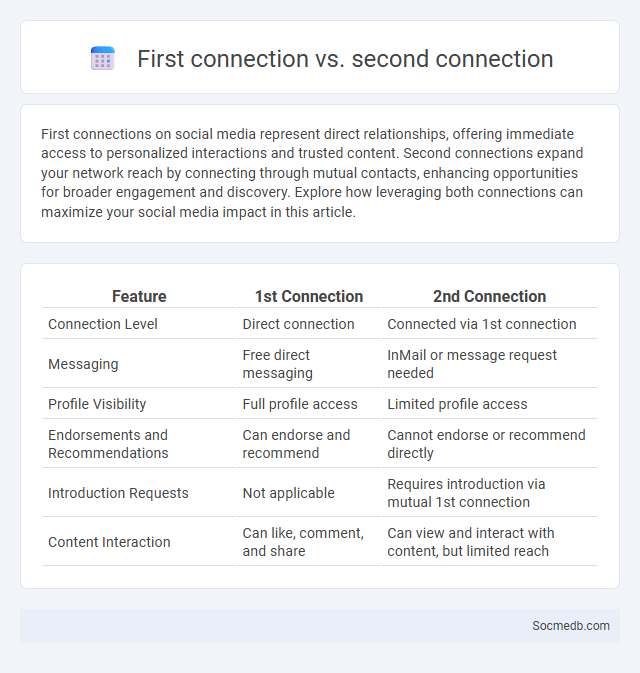
Photo illustration: 1st connection vs 2nd connection
First connections on social media represent direct relationships, offering immediate access to personalized interactions and trusted content. Second connections expand your network reach by connecting through mutual contacts, enhancing opportunities for broader engagement and discovery. Explore how leveraging both connections can maximize your social media impact in this article.
Table of Comparison
| Feature | 1st Connection | 2nd Connection |
|---|---|---|
| Connection Level | Direct connection | Connected via 1st connection |
| Messaging | Free direct messaging | InMail or message request needed |
| Profile Visibility | Full profile access | Limited profile access |
| Endorsements and Recommendations | Can endorse and recommend | Cannot endorse or recommend directly |
| Introduction Requests | Not applicable | Requires introduction via mutual 1st connection |
| Content Interaction | Can like, comment, and share | Can view and interact with content, but limited reach |
Understanding 1st Connection: Definition and Examples
Understanding your 1st connection in social media involves recognizing direct interactions, such as friends on Facebook, followers on Instagram, or connections on LinkedIn. These first-degree connections allow you to engage personally, share content, and build meaningful relationships. Leveraging these immediate contacts can boost your social presence and increase engagement metrics effectively.
What is a 2nd Connection? Key Features
A 2nd Connection on social media refers to a user who is connected to your direct (1st) connection but not directly connected to you. Key features include the ability to view mutual contacts and shared network activities, providing opportunities for expanding your professional or social network through trusted introductions. Your interactions with 2nd Connections can enhance networking efficiency and visibility within your social media platform.
Connection Degree Explained: The Basics
Connection degree refers to the number of direct or indirect links between individuals within a social media network, illustrating how closely you are connected to others. First-degree connections are your direct contacts, while second-degree connections include friends of your friends, expanding your potential reach. Understanding your connection degree helps optimize networking strategies and enhance engagement on platforms like Facebook, LinkedIn, and Instagram.
Differences Between 1st and 2nd Connections
First connections on social media represent direct relationships, such as friends, family, or colleagues you personally know, enabling immediate interaction and deeper trust. Second connections are friends of your first connections, offering broader networking opportunities but less direct engagement and familiarity. Understanding these differences helps you strategically expand your network by leveraging trusted links for introductions and new contacts.
Significance of Connection Degrees in Networks
Connection degrees in social media networks determine the strength and reach of Your influence, impacting how information propagates across platforms. Higher-degree connections enable faster content dissemination and greater engagement through indirect relationships, amplifying message visibility. Understanding these connection layers helps optimize network strategies for targeted communication and enhanced social interaction.
Impact of 1st and 2nd Connections on Networking
First and second connections on social media platforms significantly influence networking by expanding reach and fostering trust through mutual contacts. First connections offer direct interaction opportunities, while second connections enable access to broader networks without immediate introductions. Leveraging these connection degrees enhances professional visibility and facilitates strategic relationship-building essential for career growth.
Practical Applications of Connection Degree
Connection degree in social media measures the strength and number of links between users, influencing content reach and engagement. Analyzing your connection degree helps target key influencers for marketing campaigns, improving brand visibility and customer interaction. Leveraging these insights optimizes network growth and enhances personalized content delivery across platforms.
Advantages of 1st vs 2nd Connections
First-degree connections on social media are your direct contacts, offering immediate trust and personalized communication, which enhances collaboration and networking efficiency. Second-degree connections expand your reach by introducing you to potential contacts through mutual connections, increasing opportunities for business growth and information exchange. Leveraging both connection types strategically strengthens Your professional network and visibility across social platforms.
How to Expand Your Connection Degree Effectively
To expand your connection degree effectively on social media, prioritize engaging with targeted communities and influencers within your niche by commenting thoughtfully and sharing relevant content. Utilize advanced search features and hashtags to discover and connect with users who share common interests and professional goals. Consistent interaction through messages, collaborations, and participation in group discussions fosters trust and increases your network reach organically.
Choosing the Right Connection for Your Network Goals
Selecting the right social media connection is crucial for maximizing your network's impact, targeting platforms with users that align with your brand's demographics and interests. Engaging in meaningful interactions with influencers and communities that share your goals enhances visibility and fosters authentic relationships. Your strategic choice of connections directly influences growth, engagement rates, and the overall success of your social media efforts.
 socmedb.com
socmedb.com